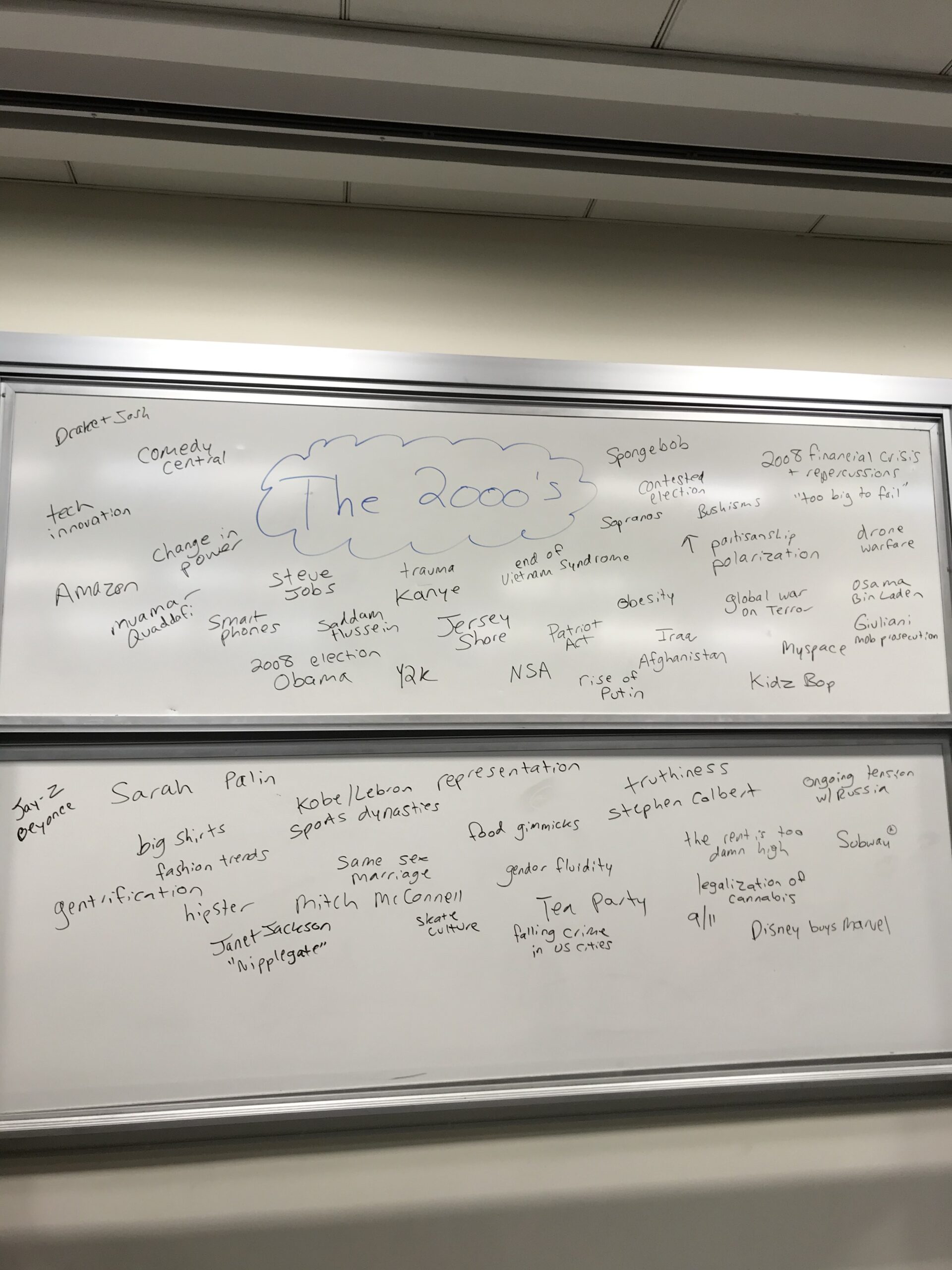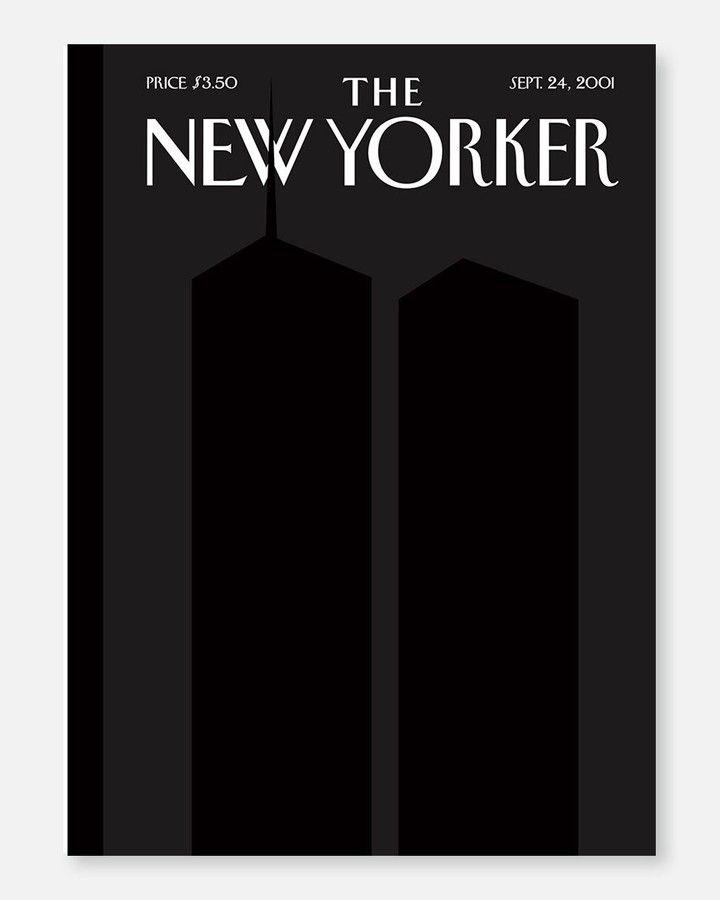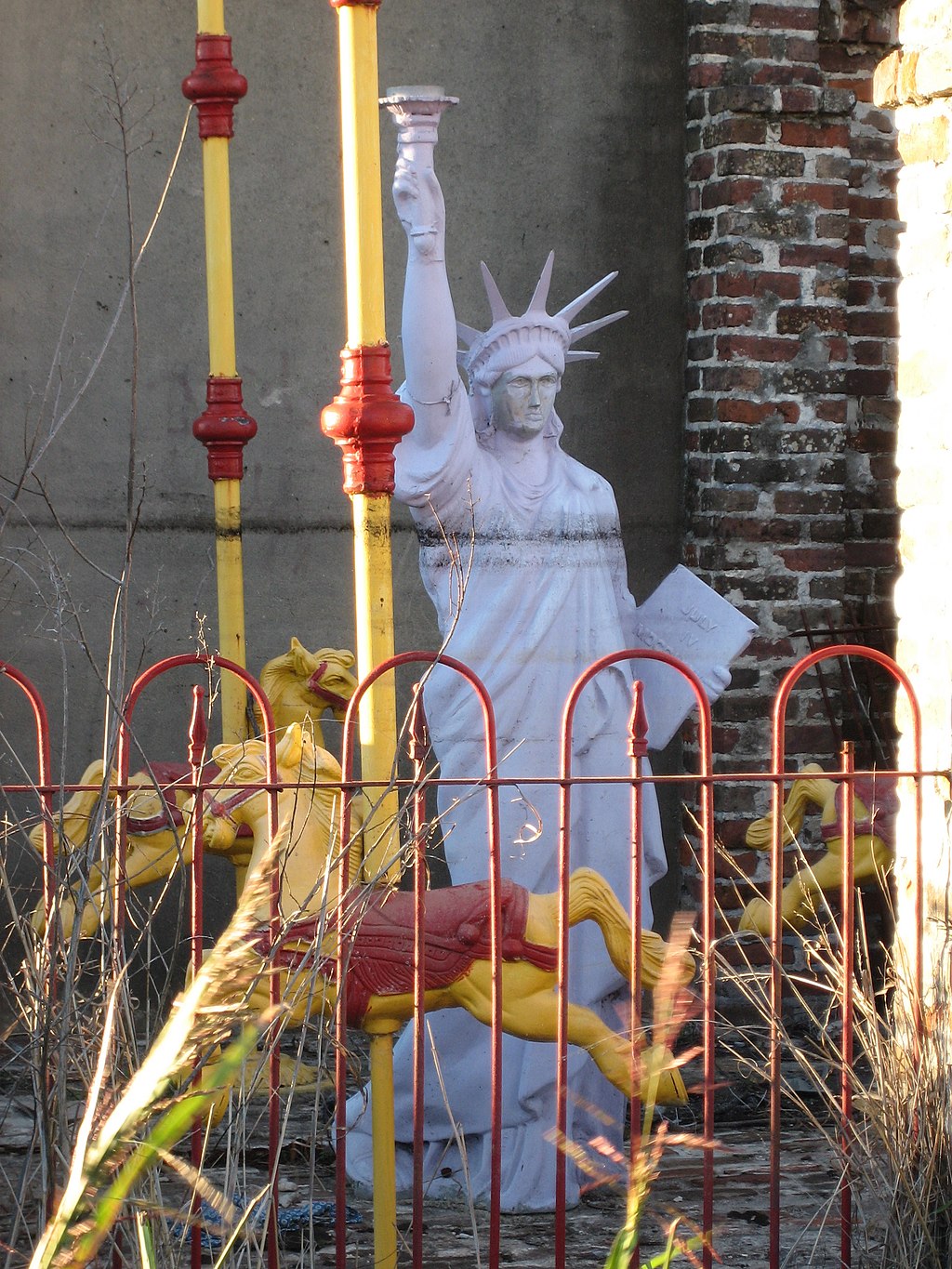By Katie Uva
I’ve been teaching at various CUNY campuses since 2011, and one of the highlights of my teaching experience has been that I’ve gotten to teach several decade-specific electives. To date, I’ve taught The Sixties, America in the 1980s, which I inherited from another professor and reworked, and America in the 2000s, which I proposed as a course topic. I was excited to teach America in the 2000s for several reasons: first, it was a formative decade in my life–I was 12 in 2000 and graduated college in 2010. Second, it was a decade that had an enormous impact on our current world–a recent work of popular history posits 2000 as “the year that broke America,” and so many of the themes, controversies, and players of the 2000s are still with us that one of the sources my class read even argues that “the 2000s never ended,” and we’re, in a sense, living in “the long 2000s.” And third, I was interested in the challenge of designing a class on a period that I was never taught as a student and that the U.S. history survey either doesn’t get to or struggles to squeeze into a final chapter at the end of the semester.
Teaching the most recent history offered challenges and opportunities. It would be challenging to develop a coherent narrative or argument for the class, since the historiography of the 2000s is just starting to develop. It would be challenging to try to offer thematic breadth while not overwhelming the class with too much information. It would be challenging to talk about formative issues of the 2000s, like terrorism, torture, LGBT rights, and climate change, when students might have personal points of connection to these issues and deeply-held conflicting viewpoints about them.
But the unsettled quality of the 2000s also offered opportunities for flexibility and input from the students. Trying to teach a challenging decade for the first time was a potent reminder to me to deemphasize myself as an authority on the topic in favor of positioning myself and the students as companions in a provisional attempt to understand the first decade of the 21st century. What follows are some highlights from the class.
First Day: 2000s Word Cloud
After doing introductions and reviewing the syllabus, I asked students to take two full minutes to list everything that comes to mind when they think of “the 2000s.” Then they got in pairs or groups of three, reintroduced themselves, and compared their lists. We reconvened and I asked students to volunteer either a) something they noticed on their list, b) something they noticed on a partner’s list, c) something that surprised them. On the basis of that I filled out a word cloud on the board.

First day word cloud. Photo by author
This activity is productive for several reasons. First, it mixes an individual activity, small group work, and a class-wide discussion. Typically everyone speaks at least a little in the process. It’s also a useful knowledge check for me–it helps me gauge peoples’ degree of familiarity with the topic and also the different directions people went with it. For instance, when I taught this class in 2020 most of my students were 18-22 so their memories of the 2000s skewed toward things like “Spongebob” and other pieces of pop culture. I also slightly adapted some of the readings based on what students said; for instance, I added a blog post about Kanye West saying “George Bush doesn’t care about Black people” to our Hurricane Katrina unit after a student mentioned it in this exercise. This word cloud also helped establish our relationship as a class early on; it communicated to students that I welcomed their input and would take their contributions seriously, it highlighted that we each have things to contribute and that collectively we bring a wide range of information to the table that is greater than any individual, and it also provided a reference point–later on when students needed to choose a research topic, I reminded them of the word cloud and welcomed them to do topics that were mentioned here, including ones that might seem light on the surface, as long as they were examined through the lens of “How did the 2000s shape this topic and how did this topic shape the 2000s?”
9/11 and Contending Truths
A lot of this class involved learning about and interpreting the attacks of September 11th. As a tragic, traumatic event with a contentious, controversial aftermath I knew this would be a challenging topic to cover. At the same time, another risk of dealing with 9/11 was actually the opposite–from my experience in other public history settings I knew that people often have a sort of clipped, too-settled way of talking about it as a tragedy that “brought us all together.” I wanted to complicate that idea with the class–to challenge a pat narrative of 9/11 as a unifying moment and to validate other perspectives the class might have on what had caused 9/11 and what its impact and implications were. To that end, I assigned a mix of sources: a contextual history chapter written several years later; official remarks by George W. Bush and Rudy Giuliani at the time, and excerpts from the New Yorker and The New York Times that sampled a variety of quotes and assessments from across the political spectrum–a kind of snapshot of the discourse in September 2001.
In class I offered students a framework for reading these sources adapted from Sites of Conscience’s Four Truths model. [1] The Four Truths splits the concept of truth into four distinct types: forensic truth, which are the facts of the event; the personal truth, which is someone’s lived experience of the event; the social truth, which can also be considered the “master narrative” of the event, and the reconciliatory or restorative truth, the process of incorporating the previous three truths into a shared understanding that promotes healing and moving forward in a moral way.

The September 24, 2001 copy of the New Yorker.
Looking at the readings through this lens wasn’t completely conclusive but it was a productive process for engaging with the sources and bringing them into conversation with each other. Students attributed the idea of “being united” and “standing strong” in particular to Rudy Giuliani and George W. Bush’s speeches, and tended to put that in the “social truth” category. Students also noted the instability of each of these categories, even the forensic truth. While this is typically the truth that traffics in agreed upon facts, students noted that the rarer but nevertheless present social truth of 9/11 being an “inside job” or conspiracy relied on defiance of the forensic truth.
The New Yorker and New York Times material provided a wealth of conflicting personal truths–some voices in those readings saw 9/11 as punishment for America’s immorality (Jerry Falwell), as inevitable revenge against imperial overreach (Barbara Ehrenreich), as demanding swift military action (Andrew Sullivan) or as demanding love in response (Alice Walker). Students also layered their own personal truths and those of their families onto this category–I had students whose family members had narrowly escaped death on 9/11, who worked as paramedics on 9/11, and whose families had been profiled and harassed because of their perceived foreignness afterwards. The opportunity to contribute those truths and see the breadth and fundamental incompatibility of many of the personal truths we amassed in this category helped highlight the challenge and the importance of reaching a restorative truth. I had originally taught this class in Spring 2020, though it’s worth noting that when I taught a shorter asynchronous version this past June some students posited that the United States’ departure from Afghanistan in 2021, however fraught it was, could be a step toward reaching this restorative truth. The contentiousness of the personal truth category and its relationship to the social truth category underlined some of the process of how history is written and made–20 years later, what truths have become marginal to our understanding of 9/11 and what truths have become central? Who has triumphed and who has become alienated as a result?
The Multiple Timelines of Hurricane Katrina
For our unit on Hurricane Katrina, I sought a way to cover many different sources and touch on the many different themes (climate change, racism, poverty, emergency management, local history, pop culture) with which Katrina intersects. To do this I assigned a range of sources, including: a blog post about Kanye West’s “George Bush doesn’t care about Black people” remark, a government report investigating the response to Katrina, two sets of local reporting from the New Orleans Times-Picayune and the Biloxi-Gulfport Sun-Herald, and a short article written in 2020 by Katrina survivor and climate justice writer Mary Annaise Heglar. I knew it would be a challenging collection for everyone to look at in depth, so I asked everyone to skim all the material, and then during class students got into groups and focused on subsets, with the goal of making a timeline that included Hurricane Katrina based on their assigned reading.

Lady Liberty with flood lines, Central City. Wikimedia Commons.
The result deconstructed the narrative of Katrina but provided more depth on the event, the overlapping contexts that led to it, and various effects that have rippled out since. The government report took the most acute look–this was a timeline of days and especially hours–one of the strong criticisms from the report was that the Governor of Louisiana and the Mayor of New Orleans waited 37 hours too long to issue a mandatory evacuation. The local papers emphasized the days survivors waited in their flooded homes to be rescued, the days they waited at the overheated and undersupplied Superdome to be bused elsewhere, the months of uncertainty about insurance payments and FEMA relief. Another local timeframe was longer in scope, noting some Gulf residents’ underestimation of Katrina based on having lived through Hurricane Camille in 1969 or Hurricane Betsy in 1965. Mary Annaise Heglar connected Katrina to environmental justice and environmental racism; in retrospect she saw in the policing of Black people after Katrina and the media emphasis on looting a burgeoning “ecofascism” that seemed to her to be accelerating in 2020. [2]
When the students presented and combined their timelines, Katrina connected to events reaching back to the founding of New Orleans in 1718 and up to the present. The act of trying to assemble a timeline raised fruitful interpretive debates of what to include and what to trim out and why. It also demonstrated the importance of combining primary sources and secondary sources in understanding an event. The local coverage was incomparable in understanding the urgent issues and the mood in the Gulf at the time, but some of the issues raised, particularly about the degree of looting and the degree of failure of different branches of government, benefited from further investigation and the passage of time. Events that hadn’t happened yet, like the BP Oil Spill and the birth of the Black Lives Matter movement, have further contextualized Katrina in meaningful ways and exposed patterns that were less evident in 2005.
In the end, America in the 2000s was one of the most substantive teaching experiences I’ve had to date. Beyond the specific topic, it also demonstrated to me the value of letting class sessions be a little more messy and more inconclusive than I’m used to as a professor.
I entrusted the students with a lot of responsibility to wade into contested topics and consider how different interpretations take root. They responded with care, sensitivity, curiosity, and amazing commitment, especially in light of the fact that the class went remote in the middle of the semester due to COVID. This was a class that was truly dependent on student input, and I am excited to see how it evolves in future iterations.
Katie Uva is the Manager of Editorial Projects at the Teaching and Learning Center, and an Adjunct Lecturer at Lehman College and Baruch College.
To view the reading list for this class, click here: America in the 2000s VP readings
Notes
[1] The International Coalition of Sites of Conscience, founded in 1999, is a global network of historic sites, museums, and memorials that is dedicated to promote and protect human rights in different regions of the world. These are often sites where atrocities or human rights abuses have occurred, and which are dedicated to preserving and interpreting that history as an act of stewardship, remembrance, and healing.
[2] Mary Annaise Heglar, ““Seeing Hurricane Katrina in 2020 Vision.” August 29, 2020. https://gizmodo.com/seeing-hurricane-katrina-in-2020-vision-1844885090










Michael Kramer
Teaching a similar class at SUNY Brockport this term and deeply impressed by how you taught this topic! Kudos!